Research Proposal: Customer Satisfaction in Malaysian Retail Industry
VerifiedAdded on 2023/06/11
|22
|4741
|164
Report
AI Summary
This research design proposal aims to investigate the key determinants of customer satisfaction within the Malaysian retail industry, focusing on 7-Eleven Malaysia Holdings Berhad. The proposal outlines the research's purpose, problem statement, research questions, and objectives, emphasizing the need to identify factors crucial for customer retention in a competitive market. The research framework identifies quality of service and product, store quality image, customer trust and loyalty, and corporate social responsibility (CSR) as major determinants. The methodology section details the exploratory research design, positivism research philosophy, and deductive research approach. Random sampling will be used to collect quantitative data from 50 customers through questionnaires. Data analysis methods and ethical considerations are also addressed, providing a comprehensive plan for conducting the research. Desklib provides a platform to access this and similar solved assignments.
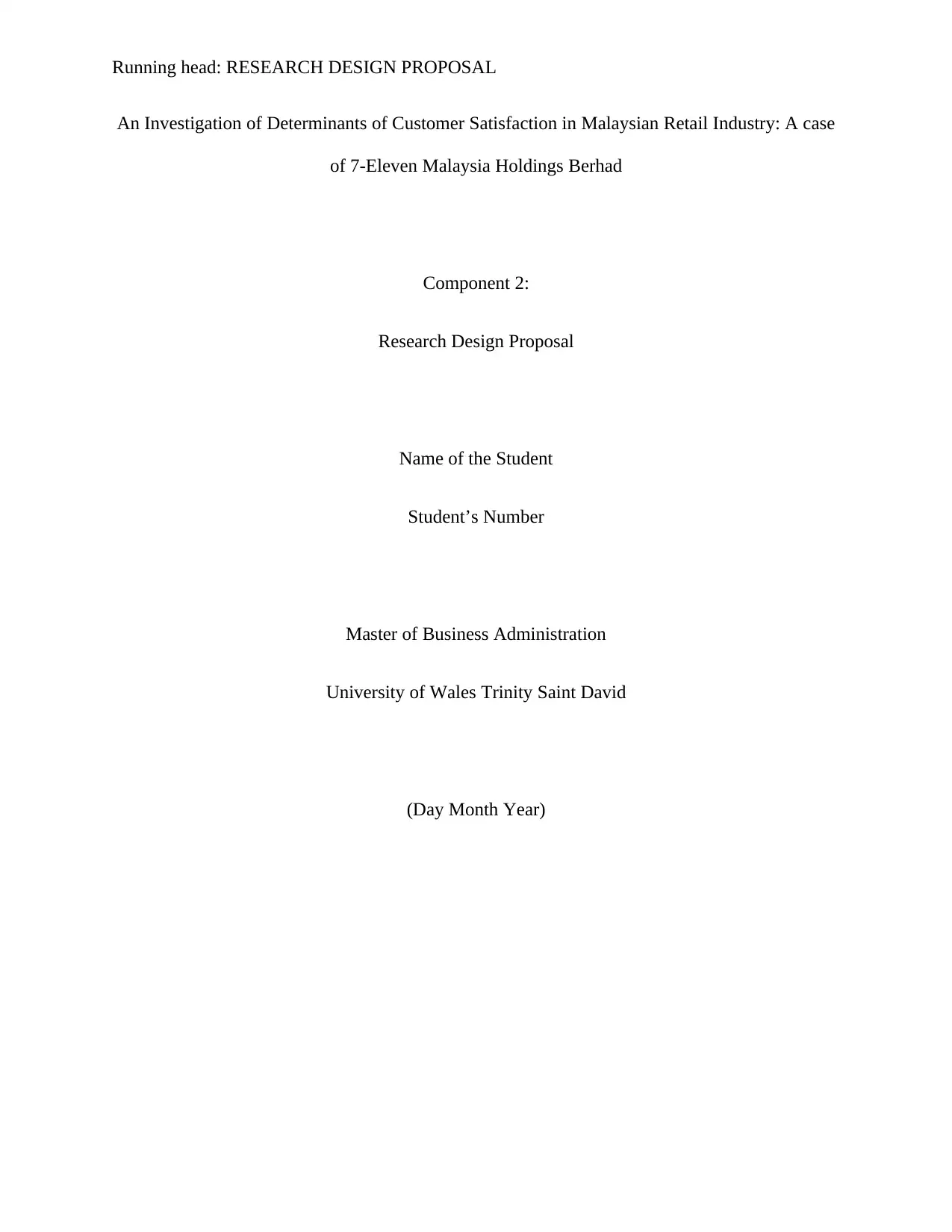
Running head: RESEARCH DESIGN PROPOSAL
An Investigation of Determinants of Customer Satisfaction in Malaysian Retail Industry: A case
of 7-Eleven Malaysia Holdings Berhad
Component 2:
Research Design Proposal
Name of the Student
Student’s Number
Master of Business Administration
University of Wales Trinity Saint David
(Day Month Year)
An Investigation of Determinants of Customer Satisfaction in Malaysian Retail Industry: A case
of 7-Eleven Malaysia Holdings Berhad
Component 2:
Research Design Proposal
Name of the Student
Student’s Number
Master of Business Administration
University of Wales Trinity Saint David
(Day Month Year)
Paraphrase This Document
Need a fresh take? Get an instant paraphrase of this document with our AI Paraphraser
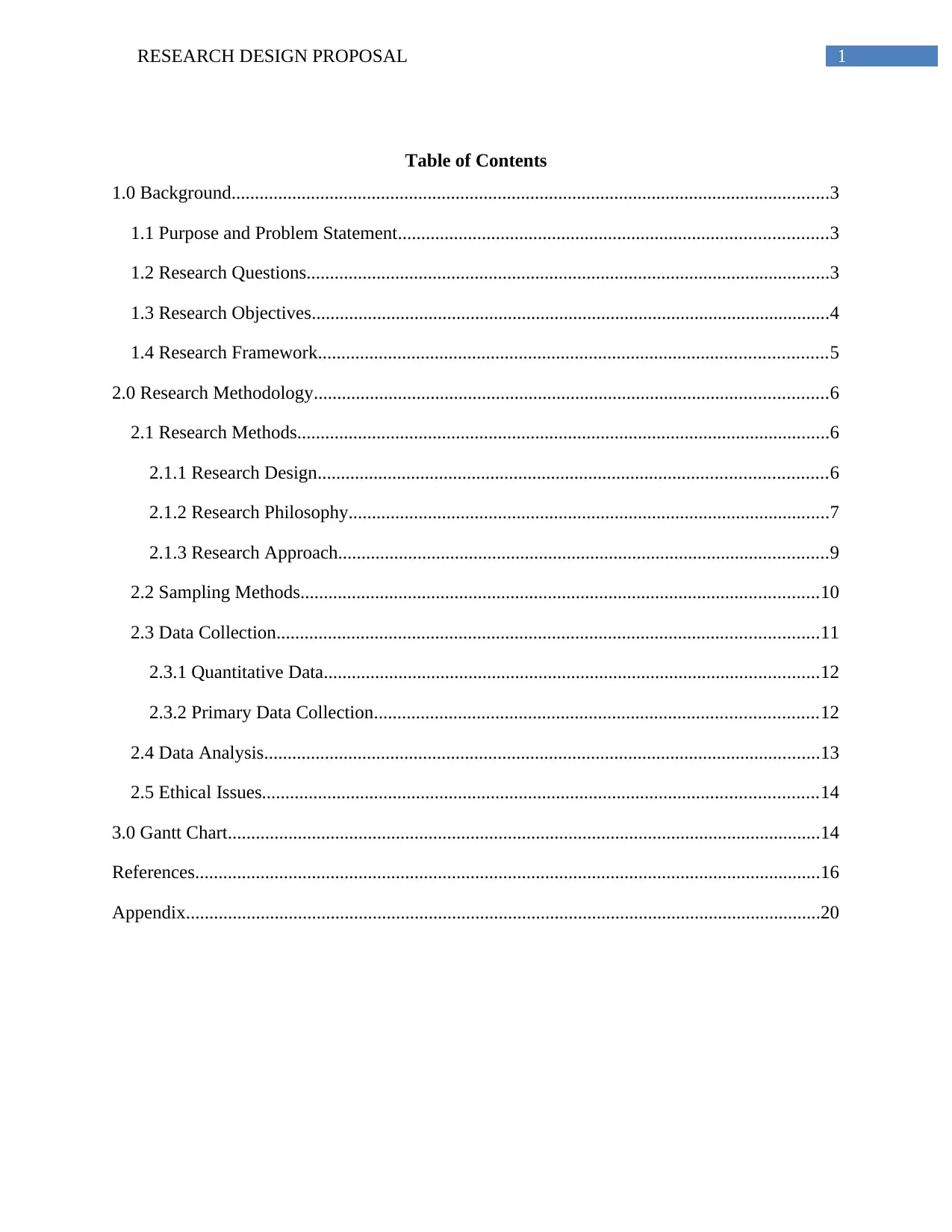
1RESEARCH DESIGN PROPOSAL
Table of Contents
1.0 Background................................................................................................................................3
1.1 Purpose and Problem Statement............................................................................................3
1.2 Research Questions................................................................................................................3
1.3 Research Objectives...............................................................................................................4
1.4 Research Framework.............................................................................................................5
2.0 Research Methodology..............................................................................................................6
2.1 Research Methods..................................................................................................................6
2.1.1 Research Design.............................................................................................................6
2.1.2 Research Philosophy.......................................................................................................7
2.1.3 Research Approach.........................................................................................................9
2.2 Sampling Methods...............................................................................................................10
2.3 Data Collection....................................................................................................................11
2.3.1 Quantitative Data..........................................................................................................12
2.3.2 Primary Data Collection...............................................................................................12
2.4 Data Analysis.......................................................................................................................13
2.5 Ethical Issues.......................................................................................................................14
3.0 Gantt Chart...............................................................................................................................14
References......................................................................................................................................16
Appendix........................................................................................................................................20
Table of Contents
1.0 Background................................................................................................................................3
1.1 Purpose and Problem Statement............................................................................................3
1.2 Research Questions................................................................................................................3
1.3 Research Objectives...............................................................................................................4
1.4 Research Framework.............................................................................................................5
2.0 Research Methodology..............................................................................................................6
2.1 Research Methods..................................................................................................................6
2.1.1 Research Design.............................................................................................................6
2.1.2 Research Philosophy.......................................................................................................7
2.1.3 Research Approach.........................................................................................................9
2.2 Sampling Methods...............................................................................................................10
2.3 Data Collection....................................................................................................................11
2.3.1 Quantitative Data..........................................................................................................12
2.3.2 Primary Data Collection...............................................................................................12
2.4 Data Analysis.......................................................................................................................13
2.5 Ethical Issues.......................................................................................................................14
3.0 Gantt Chart...............................................................................................................................14
References......................................................................................................................................16
Appendix........................................................................................................................................20
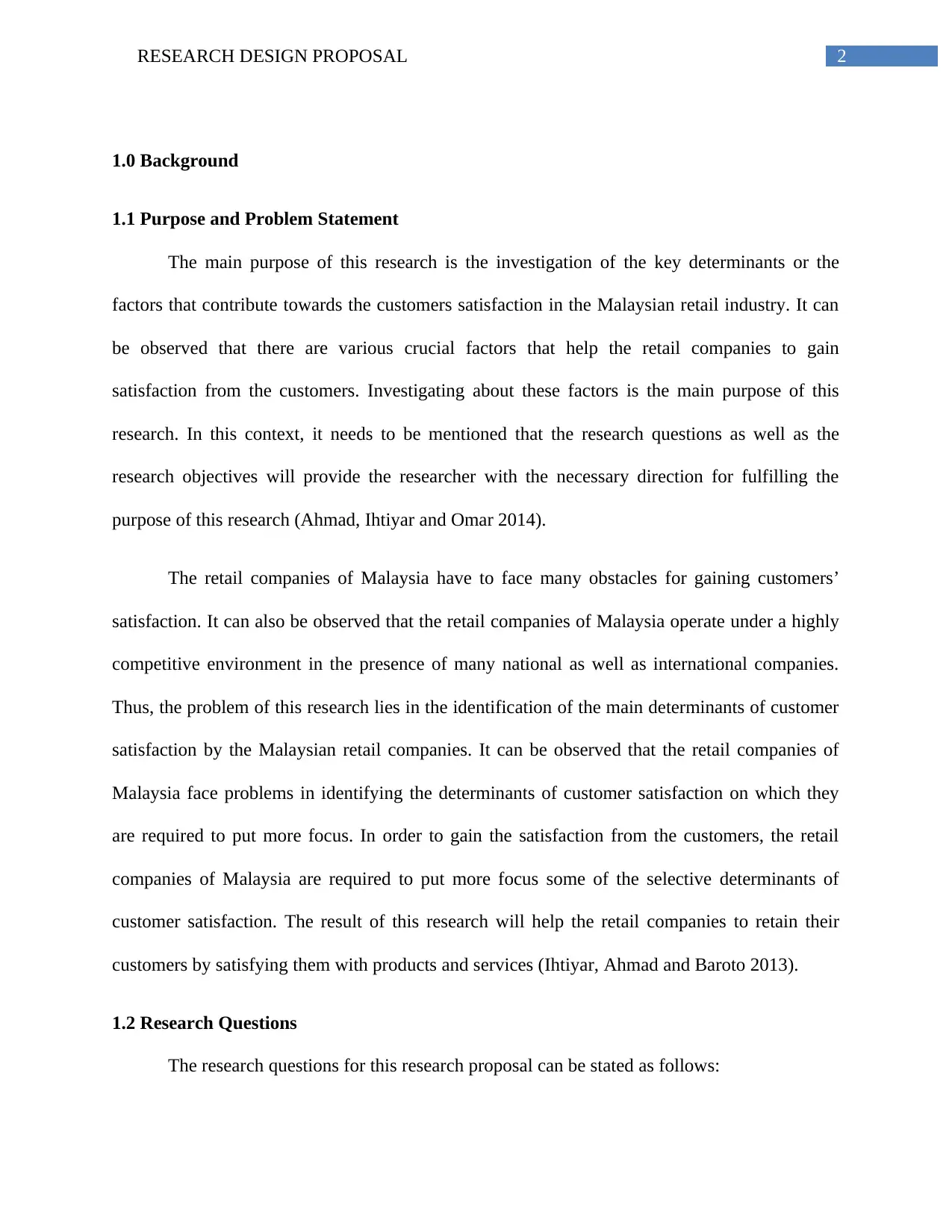
2RESEARCH DESIGN PROPOSAL
1.0 Background
1.1 Purpose and Problem Statement
The main purpose of this research is the investigation of the key determinants or the
factors that contribute towards the customers satisfaction in the Malaysian retail industry. It can
be observed that there are various crucial factors that help the retail companies to gain
satisfaction from the customers. Investigating about these factors is the main purpose of this
research. In this context, it needs to be mentioned that the research questions as well as the
research objectives will provide the researcher with the necessary direction for fulfilling the
purpose of this research (Ahmad, Ihtiyar and Omar 2014).
The retail companies of Malaysia have to face many obstacles for gaining customers’
satisfaction. It can also be observed that the retail companies of Malaysia operate under a highly
competitive environment in the presence of many national as well as international companies.
Thus, the problem of this research lies in the identification of the main determinants of customer
satisfaction by the Malaysian retail companies. It can be observed that the retail companies of
Malaysia face problems in identifying the determinants of customer satisfaction on which they
are required to put more focus. In order to gain the satisfaction from the customers, the retail
companies of Malaysia are required to put more focus some of the selective determinants of
customer satisfaction. The result of this research will help the retail companies to retain their
customers by satisfying them with products and services (Ihtiyar, Ahmad and Baroto 2013).
1.2 Research Questions
The research questions for this research proposal can be stated as follows:
1.0 Background
1.1 Purpose and Problem Statement
The main purpose of this research is the investigation of the key determinants or the
factors that contribute towards the customers satisfaction in the Malaysian retail industry. It can
be observed that there are various crucial factors that help the retail companies to gain
satisfaction from the customers. Investigating about these factors is the main purpose of this
research. In this context, it needs to be mentioned that the research questions as well as the
research objectives will provide the researcher with the necessary direction for fulfilling the
purpose of this research (Ahmad, Ihtiyar and Omar 2014).
The retail companies of Malaysia have to face many obstacles for gaining customers’
satisfaction. It can also be observed that the retail companies of Malaysia operate under a highly
competitive environment in the presence of many national as well as international companies.
Thus, the problem of this research lies in the identification of the main determinants of customer
satisfaction by the Malaysian retail companies. It can be observed that the retail companies of
Malaysia face problems in identifying the determinants of customer satisfaction on which they
are required to put more focus. In order to gain the satisfaction from the customers, the retail
companies of Malaysia are required to put more focus some of the selective determinants of
customer satisfaction. The result of this research will help the retail companies to retain their
customers by satisfying them with products and services (Ihtiyar, Ahmad and Baroto 2013).
1.2 Research Questions
The research questions for this research proposal can be stated as follows:
⊘ This is a preview!⊘
Do you want full access?
Subscribe today to unlock all pages.

Trusted by 1+ million students worldwide
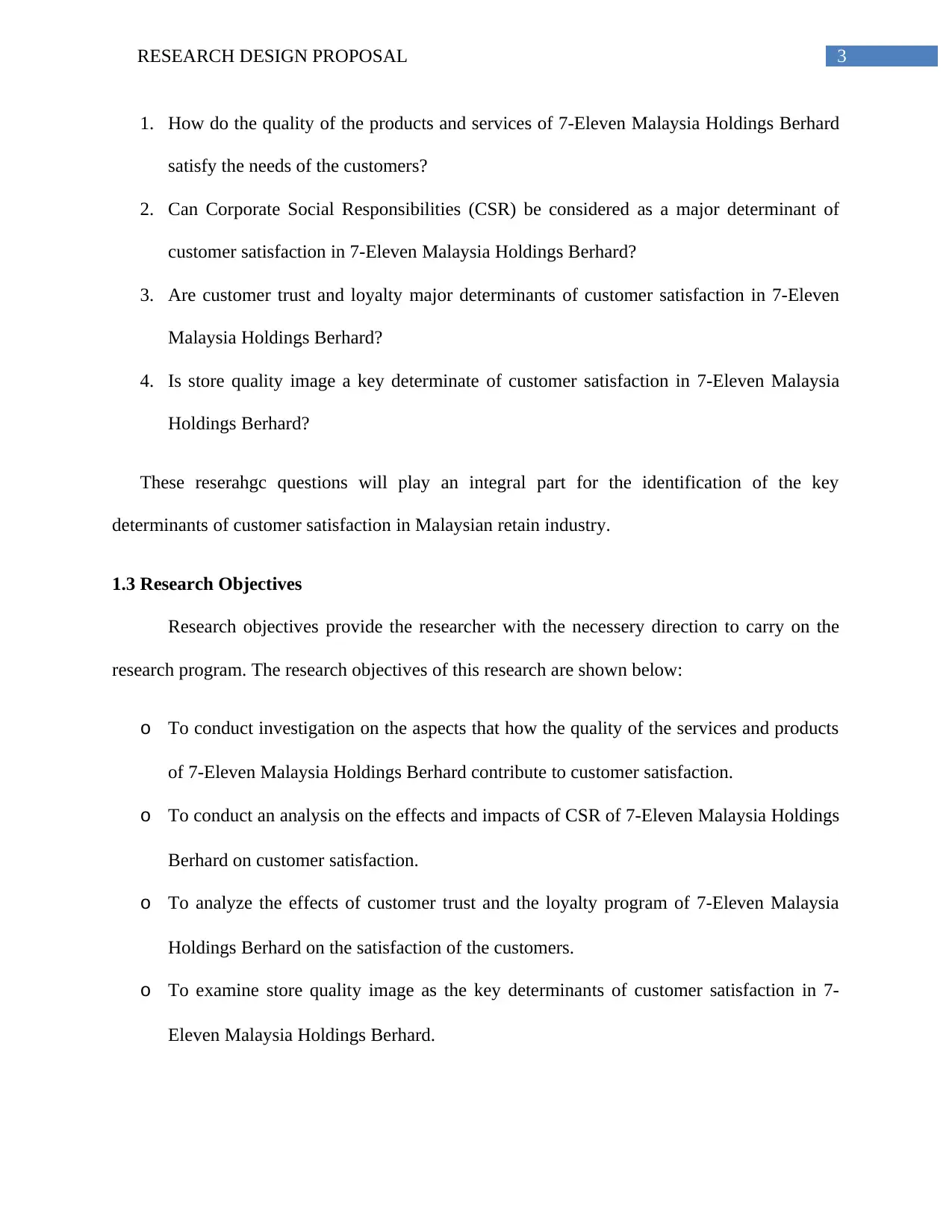
3RESEARCH DESIGN PROPOSAL
1. How do the quality of the products and services of 7-Eleven Malaysia Holdings Berhard
satisfy the needs of the customers?
2. Can Corporate Social Responsibilities (CSR) be considered as a major determinant of
customer satisfaction in 7-Eleven Malaysia Holdings Berhard?
3. Are customer trust and loyalty major determinants of customer satisfaction in 7-Eleven
Malaysia Holdings Berhard?
4. Is store quality image a key determinate of customer satisfaction in 7-Eleven Malaysia
Holdings Berhard?
These reserahgc questions will play an integral part for the identification of the key
determinants of customer satisfaction in Malaysian retain industry.
1.3 Research Objectives
Research objectives provide the researcher with the necessery direction to carry on the
research program. The research objectives of this research are shown below:
o To conduct investigation on the aspects that how the quality of the services and products
of 7-Eleven Malaysia Holdings Berhard contribute to customer satisfaction.
o To conduct an analysis on the effects and impacts of CSR of 7-Eleven Malaysia Holdings
Berhard on customer satisfaction.
o To analyze the effects of customer trust and the loyalty program of 7-Eleven Malaysia
Holdings Berhard on the satisfaction of the customers.
o To examine store quality image as the key determinants of customer satisfaction in 7-
Eleven Malaysia Holdings Berhard.
1. How do the quality of the products and services of 7-Eleven Malaysia Holdings Berhard
satisfy the needs of the customers?
2. Can Corporate Social Responsibilities (CSR) be considered as a major determinant of
customer satisfaction in 7-Eleven Malaysia Holdings Berhard?
3. Are customer trust and loyalty major determinants of customer satisfaction in 7-Eleven
Malaysia Holdings Berhard?
4. Is store quality image a key determinate of customer satisfaction in 7-Eleven Malaysia
Holdings Berhard?
These reserahgc questions will play an integral part for the identification of the key
determinants of customer satisfaction in Malaysian retain industry.
1.3 Research Objectives
Research objectives provide the researcher with the necessery direction to carry on the
research program. The research objectives of this research are shown below:
o To conduct investigation on the aspects that how the quality of the services and products
of 7-Eleven Malaysia Holdings Berhard contribute to customer satisfaction.
o To conduct an analysis on the effects and impacts of CSR of 7-Eleven Malaysia Holdings
Berhard on customer satisfaction.
o To analyze the effects of customer trust and the loyalty program of 7-Eleven Malaysia
Holdings Berhard on the satisfaction of the customers.
o To examine store quality image as the key determinants of customer satisfaction in 7-
Eleven Malaysia Holdings Berhard.
Paraphrase This Document
Need a fresh take? Get an instant paraphrase of this document with our AI Paraphraser
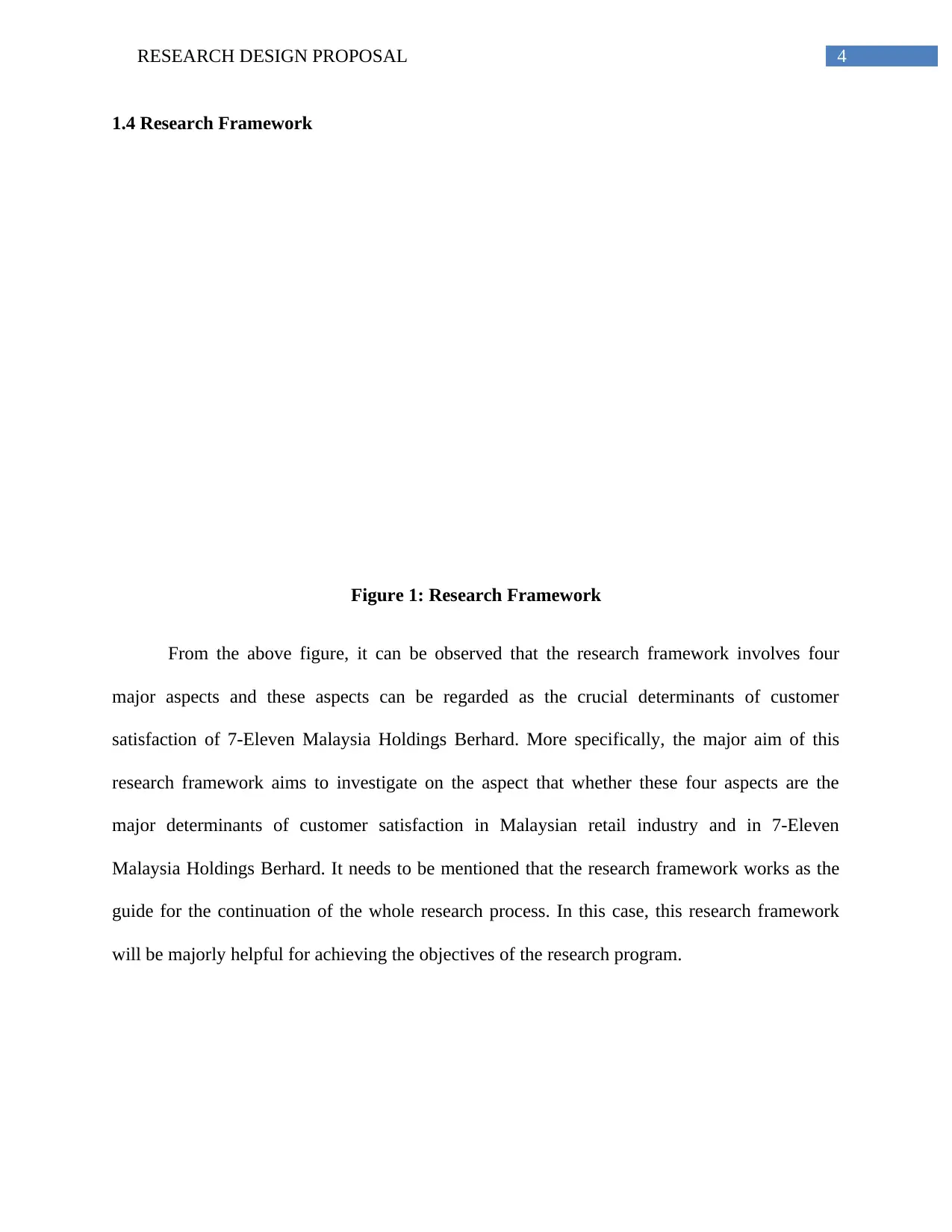
4RESEARCH DESIGN PROPOSAL
1.4 Research Framework
Figure 1: Research Framework
From the above figure, it can be observed that the research framework involves four
major aspects and these aspects can be regarded as the crucial determinants of customer
satisfaction of 7-Eleven Malaysia Holdings Berhard. More specifically, the major aim of this
research framework aims to investigate on the aspect that whether these four aspects are the
major determinants of customer satisfaction in Malaysian retail industry and in 7-Eleven
Malaysia Holdings Berhard. It needs to be mentioned that the research framework works as the
guide for the continuation of the whole research process. In this case, this research framework
will be majorly helpful for achieving the objectives of the research program.
CUSTOMERSATISFACTIONQualityofServiceandProductCustomerTrustandLoyaltyCSRStoreQualityImpage
1.4 Research Framework
Figure 1: Research Framework
From the above figure, it can be observed that the research framework involves four
major aspects and these aspects can be regarded as the crucial determinants of customer
satisfaction of 7-Eleven Malaysia Holdings Berhard. More specifically, the major aim of this
research framework aims to investigate on the aspect that whether these four aspects are the
major determinants of customer satisfaction in Malaysian retail industry and in 7-Eleven
Malaysia Holdings Berhard. It needs to be mentioned that the research framework works as the
guide for the continuation of the whole research process. In this case, this research framework
will be majorly helpful for achieving the objectives of the research program.
CUSTOMERSATISFACTIONQualityofServiceandProductCustomerTrustandLoyaltyCSRStoreQualityImpage
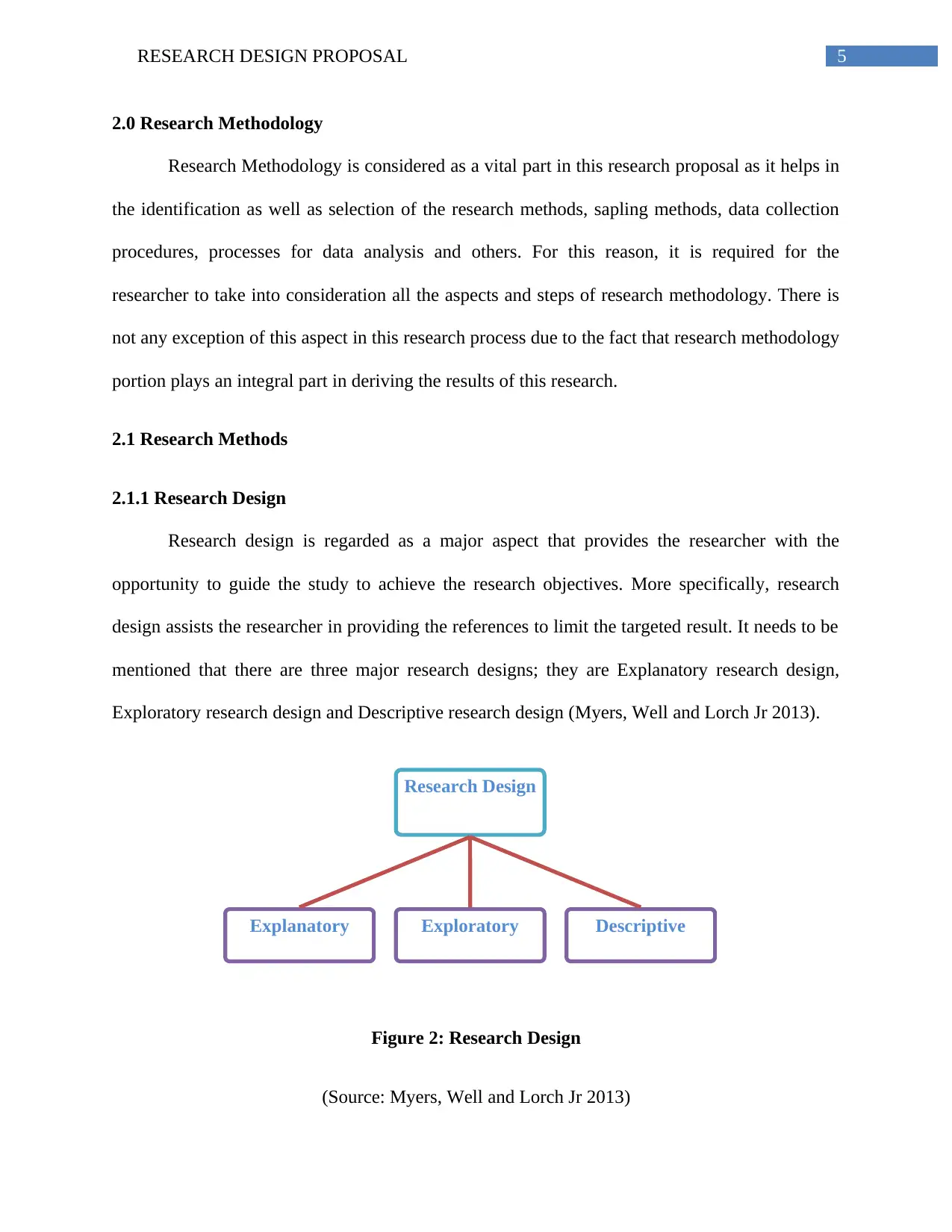
5RESEARCH DESIGN PROPOSAL
Research Design
Explanatory Exploratory Descriptive
2.0 Research Methodology
Research Methodology is considered as a vital part in this research proposal as it helps in
the identification as well as selection of the research methods, sapling methods, data collection
procedures, processes for data analysis and others. For this reason, it is required for the
researcher to take into consideration all the aspects and steps of research methodology. There is
not any exception of this aspect in this research process due to the fact that research methodology
portion plays an integral part in deriving the results of this research.
2.1 Research Methods
2.1.1 Research Design
Research design is regarded as a major aspect that provides the researcher with the
opportunity to guide the study to achieve the research objectives. More specifically, research
design assists the researcher in providing the references to limit the targeted result. It needs to be
mentioned that there are three major research designs; they are Explanatory research design,
Exploratory research design and Descriptive research design (Myers, Well and Lorch Jr 2013).
Figure 2: Research Design
(Source: Myers, Well and Lorch Jr 2013)
Research Design
Explanatory Exploratory Descriptive
2.0 Research Methodology
Research Methodology is considered as a vital part in this research proposal as it helps in
the identification as well as selection of the research methods, sapling methods, data collection
procedures, processes for data analysis and others. For this reason, it is required for the
researcher to take into consideration all the aspects and steps of research methodology. There is
not any exception of this aspect in this research process due to the fact that research methodology
portion plays an integral part in deriving the results of this research.
2.1 Research Methods
2.1.1 Research Design
Research design is regarded as a major aspect that provides the researcher with the
opportunity to guide the study to achieve the research objectives. More specifically, research
design assists the researcher in providing the references to limit the targeted result. It needs to be
mentioned that there are three major research designs; they are Explanatory research design,
Exploratory research design and Descriptive research design (Myers, Well and Lorch Jr 2013).
Figure 2: Research Design
(Source: Myers, Well and Lorch Jr 2013)
⊘ This is a preview!⊘
Do you want full access?
Subscribe today to unlock all pages.

Trusted by 1+ million students worldwide
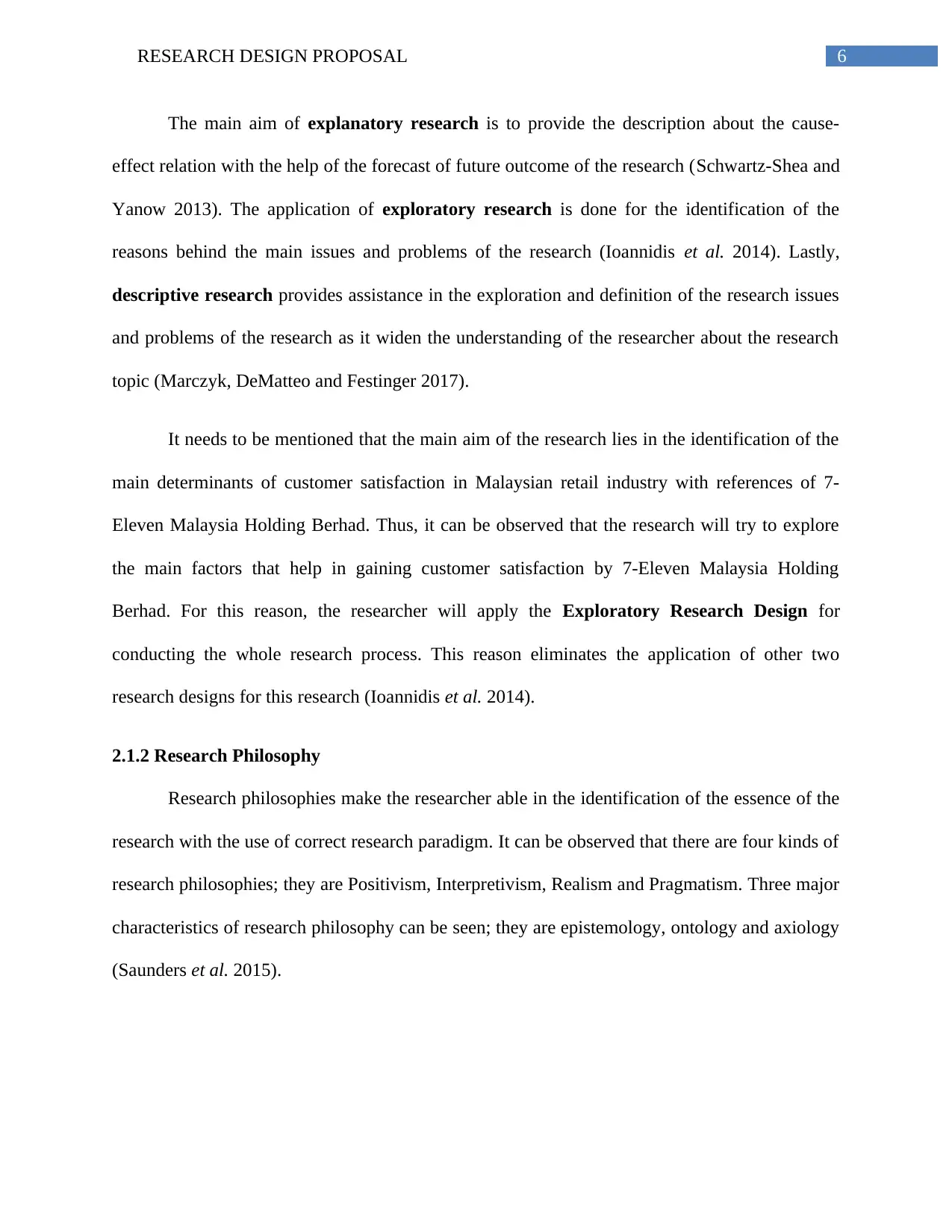
6RESEARCH DESIGN PROPOSAL
The main aim of explanatory research is to provide the description about the cause-
effect relation with the help of the forecast of future outcome of the research (Schwartz-Shea and
Yanow 2013). The application of exploratory research is done for the identification of the
reasons behind the main issues and problems of the research (Ioannidis et al. 2014). Lastly,
descriptive research provides assistance in the exploration and definition of the research issues
and problems of the research as it widen the understanding of the researcher about the research
topic (Marczyk, DeMatteo and Festinger 2017).
It needs to be mentioned that the main aim of the research lies in the identification of the
main determinants of customer satisfaction in Malaysian retail industry with references of 7-
Eleven Malaysia Holding Berhad. Thus, it can be observed that the research will try to explore
the main factors that help in gaining customer satisfaction by 7-Eleven Malaysia Holding
Berhad. For this reason, the researcher will apply the Exploratory Research Design for
conducting the whole research process. This reason eliminates the application of other two
research designs for this research (Ioannidis et al. 2014).
2.1.2 Research Philosophy
Research philosophies make the researcher able in the identification of the essence of the
research with the use of correct research paradigm. It can be observed that there are four kinds of
research philosophies; they are Positivism, Interpretivism, Realism and Pragmatism. Three major
characteristics of research philosophy can be seen; they are epistemology, ontology and axiology
(Saunders et al. 2015).
The main aim of explanatory research is to provide the description about the cause-
effect relation with the help of the forecast of future outcome of the research (Schwartz-Shea and
Yanow 2013). The application of exploratory research is done for the identification of the
reasons behind the main issues and problems of the research (Ioannidis et al. 2014). Lastly,
descriptive research provides assistance in the exploration and definition of the research issues
and problems of the research as it widen the understanding of the researcher about the research
topic (Marczyk, DeMatteo and Festinger 2017).
It needs to be mentioned that the main aim of the research lies in the identification of the
main determinants of customer satisfaction in Malaysian retail industry with references of 7-
Eleven Malaysia Holding Berhad. Thus, it can be observed that the research will try to explore
the main factors that help in gaining customer satisfaction by 7-Eleven Malaysia Holding
Berhad. For this reason, the researcher will apply the Exploratory Research Design for
conducting the whole research process. This reason eliminates the application of other two
research designs for this research (Ioannidis et al. 2014).
2.1.2 Research Philosophy
Research philosophies make the researcher able in the identification of the essence of the
research with the use of correct research paradigm. It can be observed that there are four kinds of
research philosophies; they are Positivism, Interpretivism, Realism and Pragmatism. Three major
characteristics of research philosophy can be seen; they are epistemology, ontology and axiology
(Saunders et al. 2015).
Paraphrase This Document
Need a fresh take? Get an instant paraphrase of this document with our AI Paraphraser

7RESEARCH DESIGN PROPOSAL
Research Philosophies
Positivism Interpretivism Realism Pragmatism
Figure 3: Research Philosophies
(Source: Saunders et al. 2015)
The basis of positivism research philosophy is the existence of reality with the use of
scientifically proven techniques. This research philosophy assists the researcher in the analysis of
gatherer data with the help of both qualitative as well as qualititative research approaches
(Hughes and Sharrock 2016). On the other hand, the basis of interpretivism research
philosophy is to understand the experience as well as recognition of the human beings (Ormston
et al. 2014). The application of realism research philosophy can be seen in the research
objectives (Scheurich 2014). Lastly, in order to gain greater accurately research outcomes, the
researchers use the pragmatism research philosophy as it combines both interpritivism and
positive research philosophy (Morgan 2014).
The main aim of the current research is the exploration or identification of the main
factors that contribute towards the gaining of customer satisfaction in the Malaysian retail
industry with reference to 7-Eleven Malaysia Holding Berhad. For this reason, the researcher
will apply the positivism research philosophy in this research by linking the theories related to
customer satisfaction with the current scenario (Hughes and Sharrock 2016). As this research is
Research Philosophies
Positivism Interpretivism Realism Pragmatism
Figure 3: Research Philosophies
(Source: Saunders et al. 2015)
The basis of positivism research philosophy is the existence of reality with the use of
scientifically proven techniques. This research philosophy assists the researcher in the analysis of
gatherer data with the help of both qualitative as well as qualititative research approaches
(Hughes and Sharrock 2016). On the other hand, the basis of interpretivism research
philosophy is to understand the experience as well as recognition of the human beings (Ormston
et al. 2014). The application of realism research philosophy can be seen in the research
objectives (Scheurich 2014). Lastly, in order to gain greater accurately research outcomes, the
researchers use the pragmatism research philosophy as it combines both interpritivism and
positive research philosophy (Morgan 2014).
The main aim of the current research is the exploration or identification of the main
factors that contribute towards the gaining of customer satisfaction in the Malaysian retail
industry with reference to 7-Eleven Malaysia Holding Berhad. For this reason, the researcher
will apply the positivism research philosophy in this research by linking the theories related to
customer satisfaction with the current scenario (Hughes and Sharrock 2016). As this research is

8RESEARCH DESIGN PROPOSAL
Research Approaches
Inductive Approach Deductive Approach
based on the explanatory research design, the application of positivism research philosophy will
be most relevant in order to dissect the response from the questionnaire. The main aim of not
applying the other research philosophies is that they are not based on scientifically proven
models and theories (Hughes and Sharrock 2016).
2.1.3 Research Approach
In order to arrive to the desired and actual research outcome, the selection of the
appropriate research approach is considered as a crucial aspect. The adoption of the correct
research approach helps the researcher in the identification of each step to perform the desires
research activities. There are two types of research approaches can be seen; they are Inductive
research approach and Deductive research approach (Lewis 2015).
Figure 4: Research Approaches
(Source: Lewis 2015)
With the adoption of inductive research approach, the researchers become able in
framing new models as well as theories after citing the research outcomes (Sekaran and Bougie
2016). On the other hand, the main focus of the deductive approaches can be seen on the
Research Approaches
Inductive Approach Deductive Approach
based on the explanatory research design, the application of positivism research philosophy will
be most relevant in order to dissect the response from the questionnaire. The main aim of not
applying the other research philosophies is that they are not based on scientifically proven
models and theories (Hughes and Sharrock 2016).
2.1.3 Research Approach
In order to arrive to the desired and actual research outcome, the selection of the
appropriate research approach is considered as a crucial aspect. The adoption of the correct
research approach helps the researcher in the identification of each step to perform the desires
research activities. There are two types of research approaches can be seen; they are Inductive
research approach and Deductive research approach (Lewis 2015).
Figure 4: Research Approaches
(Source: Lewis 2015)
With the adoption of inductive research approach, the researchers become able in
framing new models as well as theories after citing the research outcomes (Sekaran and Bougie
2016). On the other hand, the main focus of the deductive approaches can be seen on the
⊘ This is a preview!⊘
Do you want full access?
Subscribe today to unlock all pages.

Trusted by 1+ million students worldwide
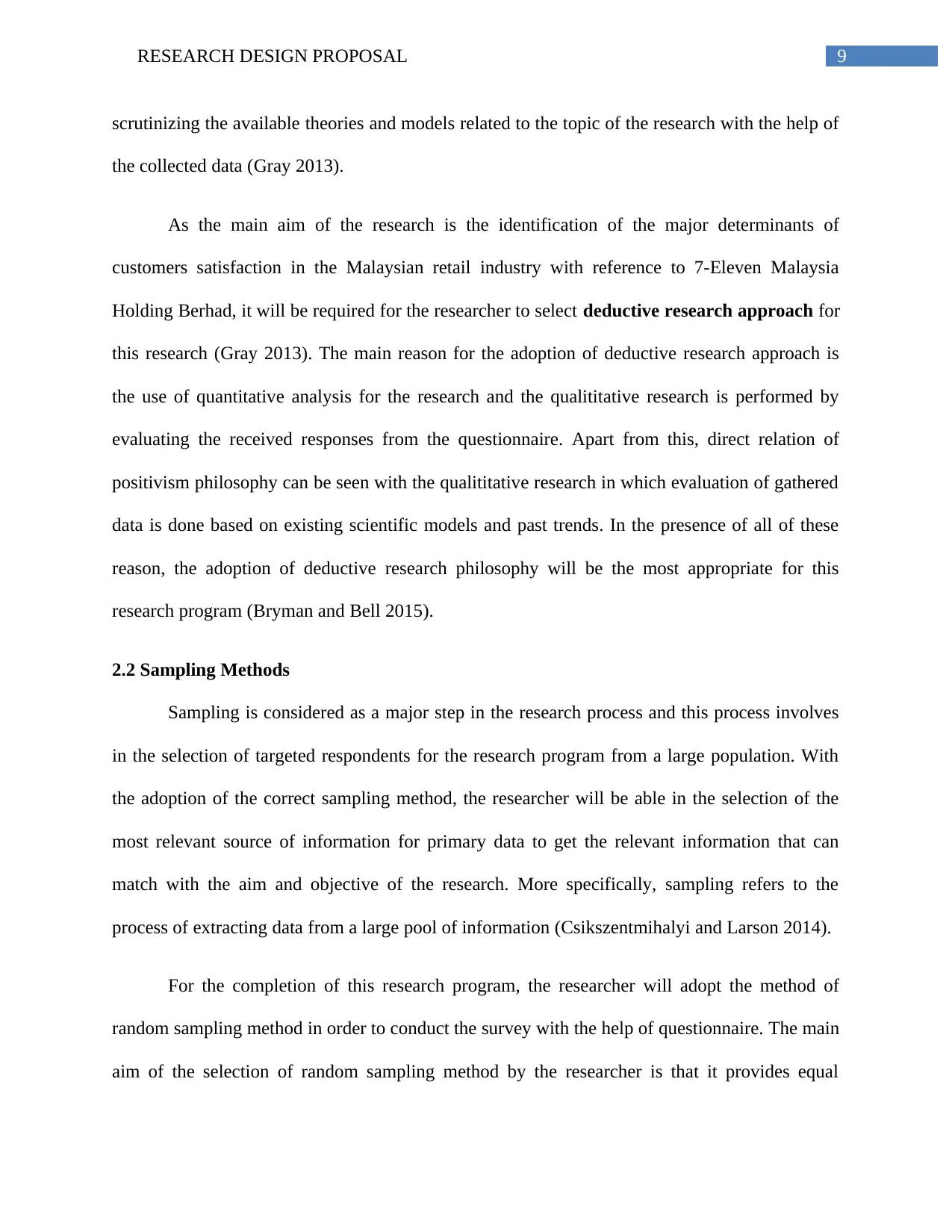
9RESEARCH DESIGN PROPOSAL
scrutinizing the available theories and models related to the topic of the research with the help of
the collected data (Gray 2013).
As the main aim of the research is the identification of the major determinants of
customers satisfaction in the Malaysian retail industry with reference to 7-Eleven Malaysia
Holding Berhad, it will be required for the researcher to select deductive research approach for
this research (Gray 2013). The main reason for the adoption of deductive research approach is
the use of quantitative analysis for the research and the qualititative research is performed by
evaluating the received responses from the questionnaire. Apart from this, direct relation of
positivism philosophy can be seen with the qualititative research in which evaluation of gathered
data is done based on existing scientific models and past trends. In the presence of all of these
reason, the adoption of deductive research philosophy will be the most appropriate for this
research program (Bryman and Bell 2015).
2.2 Sampling Methods
Sampling is considered as a major step in the research process and this process involves
in the selection of targeted respondents for the research program from a large population. With
the adoption of the correct sampling method, the researcher will be able in the selection of the
most relevant source of information for primary data to get the relevant information that can
match with the aim and objective of the research. More specifically, sampling refers to the
process of extracting data from a large pool of information (Csikszentmihalyi and Larson 2014).
For the completion of this research program, the researcher will adopt the method of
random sampling method in order to conduct the survey with the help of questionnaire. The main
aim of the selection of random sampling method by the researcher is that it provides equal
scrutinizing the available theories and models related to the topic of the research with the help of
the collected data (Gray 2013).
As the main aim of the research is the identification of the major determinants of
customers satisfaction in the Malaysian retail industry with reference to 7-Eleven Malaysia
Holding Berhad, it will be required for the researcher to select deductive research approach for
this research (Gray 2013). The main reason for the adoption of deductive research approach is
the use of quantitative analysis for the research and the qualititative research is performed by
evaluating the received responses from the questionnaire. Apart from this, direct relation of
positivism philosophy can be seen with the qualititative research in which evaluation of gathered
data is done based on existing scientific models and past trends. In the presence of all of these
reason, the adoption of deductive research philosophy will be the most appropriate for this
research program (Bryman and Bell 2015).
2.2 Sampling Methods
Sampling is considered as a major step in the research process and this process involves
in the selection of targeted respondents for the research program from a large population. With
the adoption of the correct sampling method, the researcher will be able in the selection of the
most relevant source of information for primary data to get the relevant information that can
match with the aim and objective of the research. More specifically, sampling refers to the
process of extracting data from a large pool of information (Csikszentmihalyi and Larson 2014).
For the completion of this research program, the researcher will adopt the method of
random sampling method in order to conduct the survey with the help of questionnaire. The main
aim of the selection of random sampling method by the researcher is that it provides equal
Paraphrase This Document
Need a fresh take? Get an instant paraphrase of this document with our AI Paraphraser
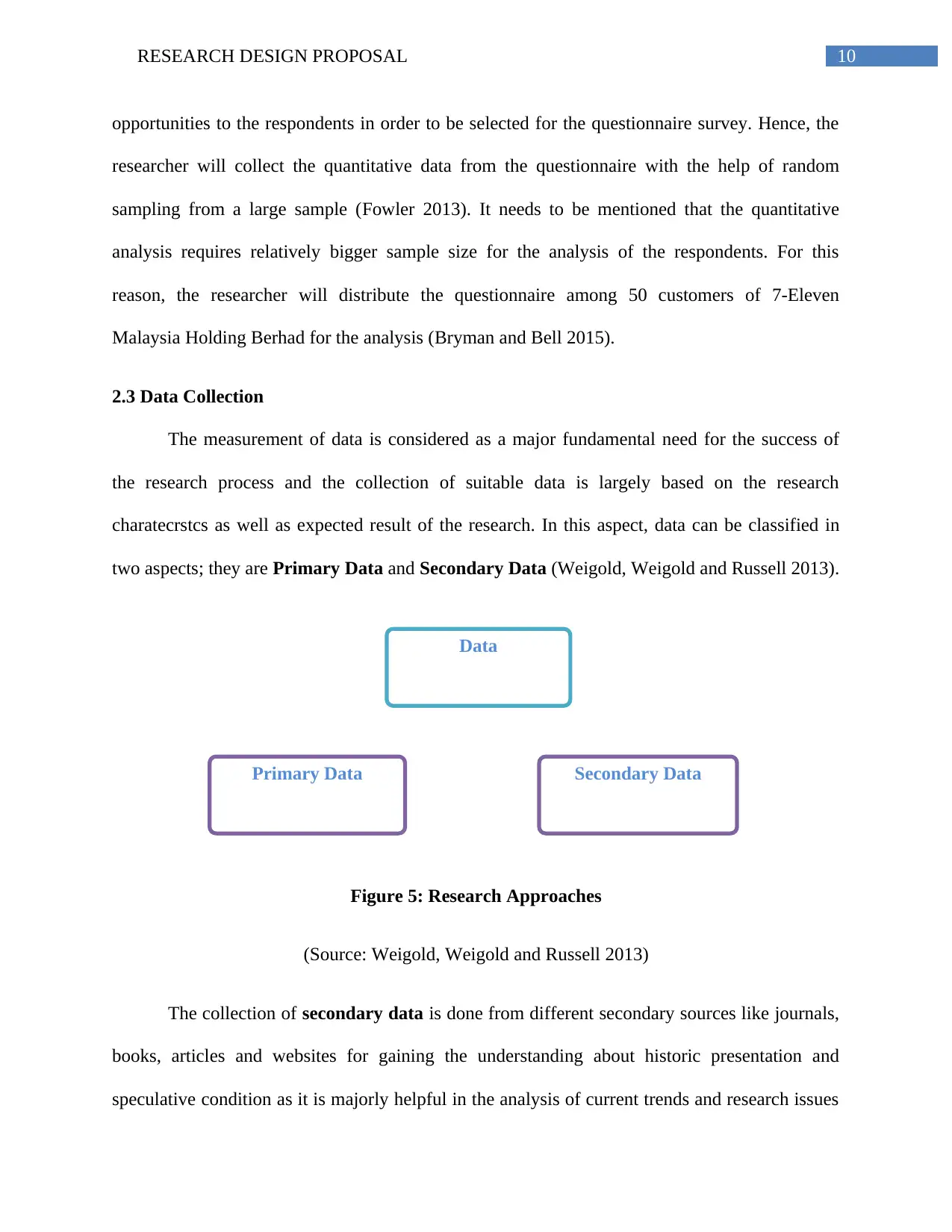
10RESEARCH DESIGN PROPOSAL
Data
Primary Data Secondary Data
opportunities to the respondents in order to be selected for the questionnaire survey. Hence, the
researcher will collect the quantitative data from the questionnaire with the help of random
sampling from a large sample (Fowler 2013). It needs to be mentioned that the quantitative
analysis requires relatively bigger sample size for the analysis of the respondents. For this
reason, the researcher will distribute the questionnaire among 50 customers of 7-Eleven
Malaysia Holding Berhad for the analysis (Bryman and Bell 2015).
2.3 Data Collection
The measurement of data is considered as a major fundamental need for the success of
the research process and the collection of suitable data is largely based on the research
charatecrstcs as well as expected result of the research. In this aspect, data can be classified in
two aspects; they are Primary Data and Secondary Data (Weigold, Weigold and Russell 2013).
Figure 5: Research Approaches
(Source: Weigold, Weigold and Russell 2013)
The collection of secondary data is done from different secondary sources like journals,
books, articles and websites for gaining the understanding about historic presentation and
speculative condition as it is majorly helpful in the analysis of current trends and research issues
Data
Primary Data Secondary Data
opportunities to the respondents in order to be selected for the questionnaire survey. Hence, the
researcher will collect the quantitative data from the questionnaire with the help of random
sampling from a large sample (Fowler 2013). It needs to be mentioned that the quantitative
analysis requires relatively bigger sample size for the analysis of the respondents. For this
reason, the researcher will distribute the questionnaire among 50 customers of 7-Eleven
Malaysia Holding Berhad for the analysis (Bryman and Bell 2015).
2.3 Data Collection
The measurement of data is considered as a major fundamental need for the success of
the research process and the collection of suitable data is largely based on the research
charatecrstcs as well as expected result of the research. In this aspect, data can be classified in
two aspects; they are Primary Data and Secondary Data (Weigold, Weigold and Russell 2013).
Figure 5: Research Approaches
(Source: Weigold, Weigold and Russell 2013)
The collection of secondary data is done from different secondary sources like journals,
books, articles and websites for gaining the understanding about historic presentation and
speculative condition as it is majorly helpful in the analysis of current trends and research issues
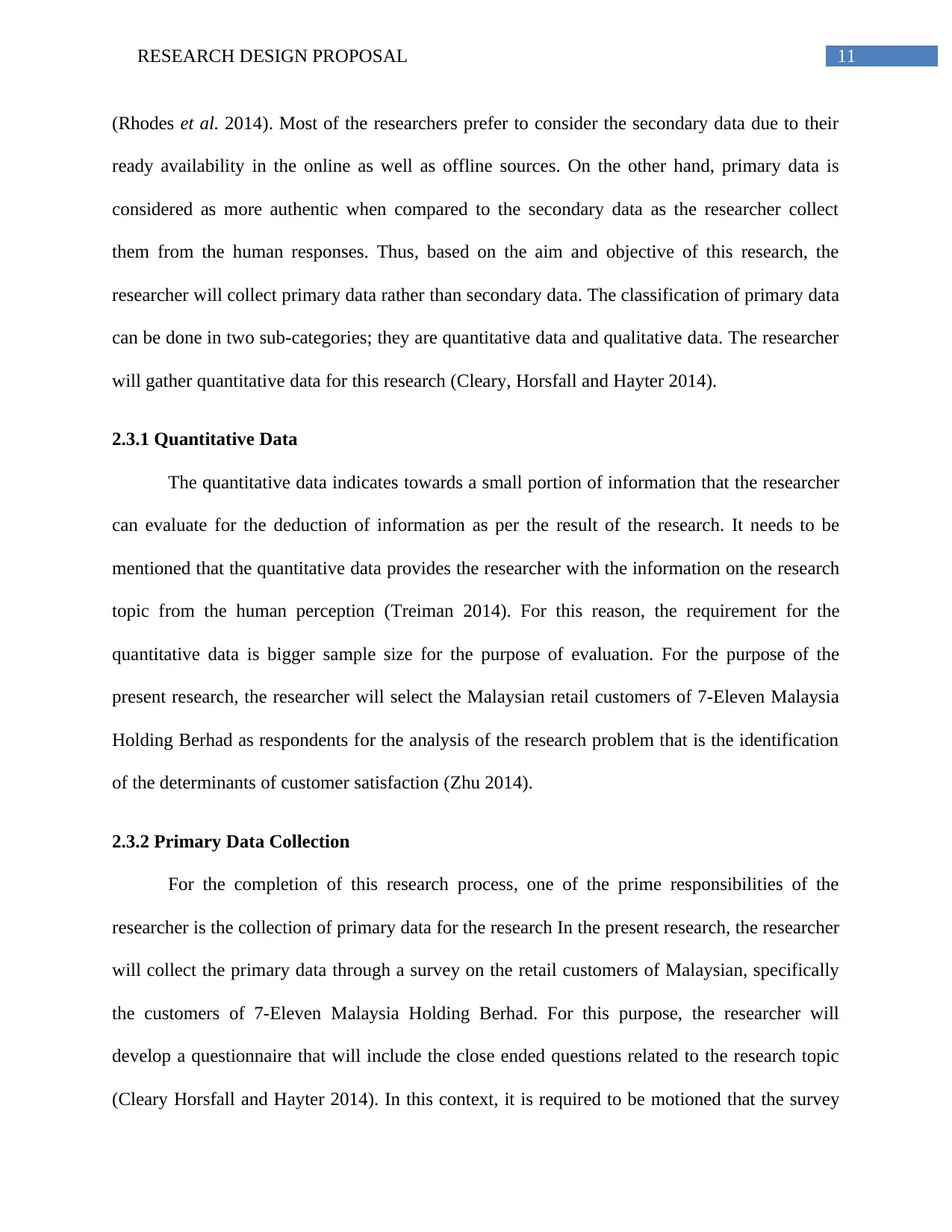
11RESEARCH DESIGN PROPOSAL
(Rhodes et al. 2014). Most of the researchers prefer to consider the secondary data due to their
ready availability in the online as well as offline sources. On the other hand, primary data is
considered as more authentic when compared to the secondary data as the researcher collect
them from the human responses. Thus, based on the aim and objective of this research, the
researcher will collect primary data rather than secondary data. The classification of primary data
can be done in two sub-categories; they are quantitative data and qualitative data. The researcher
will gather quantitative data for this research (Cleary, Horsfall and Hayter 2014).
2.3.1 Quantitative Data
The quantitative data indicates towards a small portion of information that the researcher
can evaluate for the deduction of information as per the result of the research. It needs to be
mentioned that the quantitative data provides the researcher with the information on the research
topic from the human perception (Treiman 2014). For this reason, the requirement for the
quantitative data is bigger sample size for the purpose of evaluation. For the purpose of the
present research, the researcher will select the Malaysian retail customers of 7-Eleven Malaysia
Holding Berhad as respondents for the analysis of the research problem that is the identification
of the determinants of customer satisfaction (Zhu 2014).
2.3.2 Primary Data Collection
For the completion of this research process, one of the prime responsibilities of the
researcher is the collection of primary data for the research In the present research, the researcher
will collect the primary data through a survey on the retail customers of Malaysian, specifically
the customers of 7-Eleven Malaysia Holding Berhad. For this purpose, the researcher will
develop a questionnaire that will include the close ended questions related to the research topic
(Cleary Horsfall and Hayter 2014). In this context, it is required to be motioned that the survey
(Rhodes et al. 2014). Most of the researchers prefer to consider the secondary data due to their
ready availability in the online as well as offline sources. On the other hand, primary data is
considered as more authentic when compared to the secondary data as the researcher collect
them from the human responses. Thus, based on the aim and objective of this research, the
researcher will collect primary data rather than secondary data. The classification of primary data
can be done in two sub-categories; they are quantitative data and qualitative data. The researcher
will gather quantitative data for this research (Cleary, Horsfall and Hayter 2014).
2.3.1 Quantitative Data
The quantitative data indicates towards a small portion of information that the researcher
can evaluate for the deduction of information as per the result of the research. It needs to be
mentioned that the quantitative data provides the researcher with the information on the research
topic from the human perception (Treiman 2014). For this reason, the requirement for the
quantitative data is bigger sample size for the purpose of evaluation. For the purpose of the
present research, the researcher will select the Malaysian retail customers of 7-Eleven Malaysia
Holding Berhad as respondents for the analysis of the research problem that is the identification
of the determinants of customer satisfaction (Zhu 2014).
2.3.2 Primary Data Collection
For the completion of this research process, one of the prime responsibilities of the
researcher is the collection of primary data for the research In the present research, the researcher
will collect the primary data through a survey on the retail customers of Malaysian, specifically
the customers of 7-Eleven Malaysia Holding Berhad. For this purpose, the researcher will
develop a questionnaire that will include the close ended questions related to the research topic
(Cleary Horsfall and Hayter 2014). In this context, it is required to be motioned that the survey
⊘ This is a preview!⊘
Do you want full access?
Subscribe today to unlock all pages.

Trusted by 1+ million students worldwide
1 out of 22
Related Documents
Your All-in-One AI-Powered Toolkit for Academic Success.
+13062052269
info@desklib.com
Available 24*7 on WhatsApp / Email
![[object Object]](/_next/static/media/star-bottom.7253800d.svg)
Unlock your academic potential
Copyright © 2020–2025 A2Z Services. All Rights Reserved. Developed and managed by ZUCOL.





